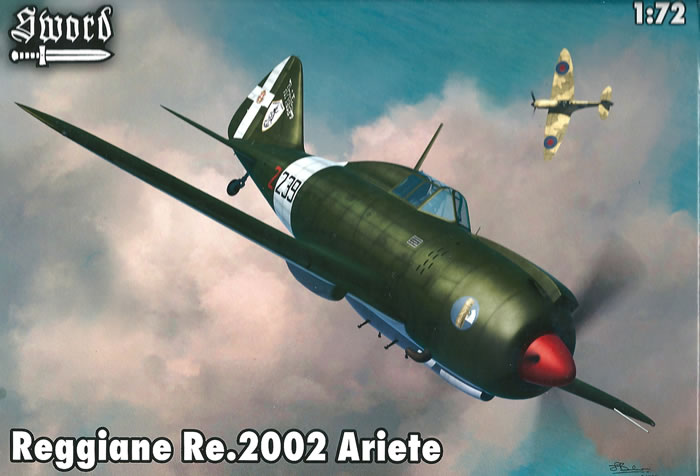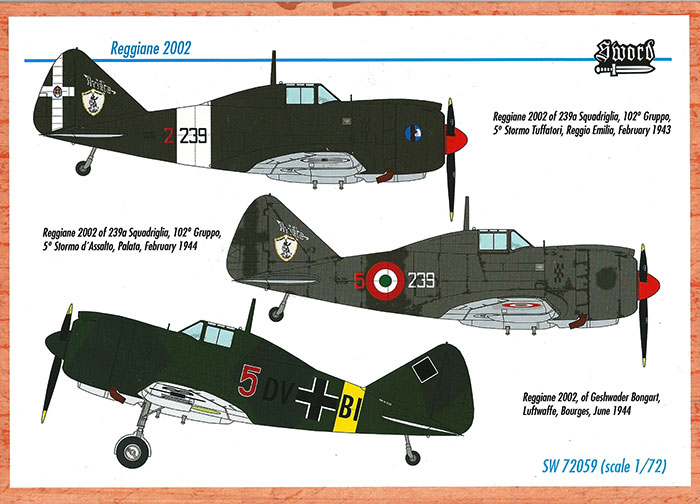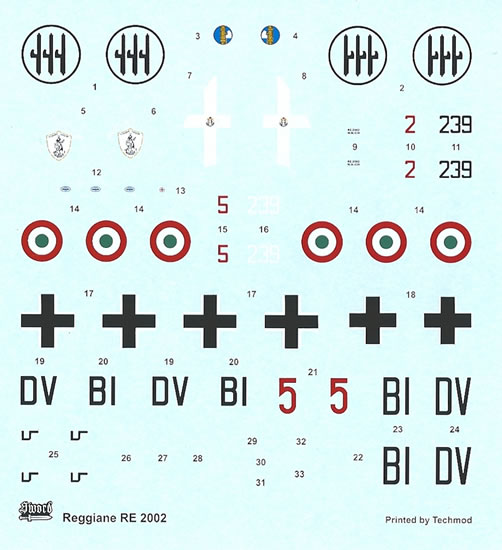Reggiane Re 2002 Ariete

Sword, 1/72 scale
S u m m a r y : |
Catalogue Number: |
Sword Kit No. SW72059 - Reggiane Re 2002 Ariete |
Scale: |
1/72 |
Contents & Media |
Forty-six grey styrene, three clear styrene, and two resin parts with decals for three colour scheme options. |
Price: |
Available online from these stockists: Hannants for £12.49, Squadron for US$29.69, Modelimex for €14.58, and West Coast Hobbys for Can$22.50. |
Review Type: |
First Look. |
Advantages: |
It has good quality production for limited run kit, positionable canopy, and good cockpit detail. |
Disadvantages: |
There are no bombs or other payloads provided. |
Conclusions: |
This looks to be a straightforward build of an interesting and attractive subject. What a pity that Sword failed to provide any bombs, as this would really add interest to the finished model. This criticism aside, I am happy to recommend the kit. |
Reviewed by
Mark Davies

Sword's 1/72 scale Ariete is available online from
Squadron.com
In 1938 the Italian Air Ministry released “Programme R” to improve the quantitative and qualitative aspects of the Regia Aeronautica. The programme included the need for modern fighters, with four models under consideration at the time. These were the Fiat G.50 and Macchi C.200, both at their prototype stage, along with the A.U.T.18 and Caproni-Vizzola F.5, which were both in advanced stages of development.
Reggiane considered licence producing a US-sourced fighter to catch up with their competitors in response to “Programme R”. Instead they designed what looked almost like a copy of the Seversky P-35, so similar was the Re 2000 Falco to the US fighter. The designer the Falco had recent experience of the American aircraft industry, having just returned from the USA to join Reggiane, and this no doubt influenced the Re2000’s design. This was to be the only fighter initiated directly in response to “Programme R”. The Re 2000 first flew in May 1939. It was a successful design for Reggiane, although possibly more as an export than for its service with the Regia Aeronautica. They sold the Falco to Sweden and Hungary, with the Hungarians also building it under licence as the Mavag Heja II.
Italian fighter development was restricted prior to WW2 by the lack of a modern V-12 water-cooled engine. This changed when their German ally granted Alfa Romeo a licence to produce the DB 601 V-12 engine. The Italians could now improve the performance of existing fighter designs by replacing their radial engines with the more powerful and streamlined V-12. The result was the Macchi C. 202 Folgore and Reggiane Re 2001 Falco II. Macchi produced the C.202 by replacing the C.200’s radial with the V-12 engine, but they made few other changes to the airframe. The Re 2000’s wing structure and integral fuel tanks had given problems in service. So aside from repowering the Re 2000, Reggiane also changed its wing structure for the Re 2001, although externally the wing appeared to be much the same. They used a three-spar wing instead of the Re 2000’s five-spar type, and replaced the earlier design’s fuel tanks with self-sealing ones. The Re 2001 was successful in its intended role, but the C.202 proved to be the better design overall.

Reggiane developed their next fighter for ground attack, and named it the Re 2002 Ariete. It had the same airframe as the Re 2001, but changed to an air-cooled radial engine for its new role. This was because an air-cooled engine was less vulnerable to ground fire a liquid-cooled V-12. Besides, by this time the V-12 was in short supply and prioritised for Macchi C.202 production. The Re 2002 first flew in October 1940 and the first production aircraft rolled of the line a year later. Despite this, the Ariete did not enter service until July 1942 due to delays in engine production. It used the same armament as the Re 2001 of two 12.7-mm and two 7.7-mm calibre machineguns. Added to this was the ability to carry one 650-kg bomb on the centreline and a 160-kg bomb under each wing.
The Re 2002 served three air arms. First with the Regia Aeronautica, that used it to oppose the allied landings in Sicily, and suffered heavy losses of them in this campaign. Then the Germans took over production after the Italian armistice in September 1943, and used their Re 2002’s against the French resistance until mid-1944. Meanwhile, the Italian Co-Belligerent Air Force flew the Ariete until the end of the war. They mainly supported partisans opposing the Germans in Northern Italy and the Balkans.
Previous 1/72 Scale Ariete Kits
I am aware of only one previous Re 2002 in the one true scale. This was by Italiaeri and shared many parts with Re 2000 and 2001 kits as well. Two new brand names emerged from the subsequent division of Italiaeri; these were Italeri and Super Model, with the latter marketing the three Reggiane fighter kits. The Super Model Re 2002 is a good kit for the 1970’s, and whilst showing its age has generally restrained raised detail that looks fine. I built the Italiaeri Re 2001 about 10 years ago, and found it to be a very clean and easy build. I expect that their Re 2002 kit will build as easily because it shares many parts with the Re 2001. Old moulds rarely die, and so it is that Italeri has since acquired the Super Model range.
Tauro Models did issue a resin Re 2001 kit, so it is quite possible that they released a Re 2002 as well. I have no other information on the Tuaro kit.
A modern kit of the Ariete is most welcome regardless of the merits of any predecessors.
Contents
This kit comes in an end-opening box with somewhat uninspiring artwork on its front. The instructions provide a parts map and have an easy to follow diagrammatic assembly format. The diagrams are well drawn, and are better than some long-run brands. There is also a brief history of the aircraft in English.
Paint colours are in Czech and English, with all other text in English. The painting and decal guide uses adequate black & white shaded 4-view drawings. Colour profiles on the rear of the box support these. Sword uses generic colour call outs for detail painting, RLM codes for the German option, and broadly descriptive names for the Italian colour scheme options. The parts come enclosed in a zip-lock bag, with the clear parts further enclosed in a small bag of their own.
This is a typical Sword kit in that the plastic has a more shiny finish than many other limited run brands. It has cleanly moulded parts with very fine surface detail. Parts break down is conventional for the type. The sprue gates are narrow, and there is just a hint of flash in places, but this a minor issue. High production standards apply to the clear parts and decals too.
The Airframe
The cockpit detail consists of a floor, rear bulkhead, headrest, rudder bar, control column and instrument panel that fit into a front bulkhead. The sidewalls have their detail moulded integrally with each fuselage half, although paired oxygen bottles are a separate part that fits to the starboard side. There is also a clear styrene gun-sight to mount atop the instrument panel. The Ariete had small but quite spacious cockpit. You need an open canopy to see most of the cockpit detail, and the kit provides for this with its thin and clear two-piece canopy.

An open canopy will also demand a seat harness however. The WW2 Italian type are a bit elaborate, so check your references, and maybe wait for BrenGun to release a PE detail set for this kit.
The kit’s engine has the two rows of cylinders moulded as one, which is fine in this scale given the Ariete’s comparatively close fitting cowl. The cylinders and pushrods are not particularly impressive in appearance, but certainly adequate. There is a separate reduction gear housing to mount in front of the cylinders. I think that overall the engine will look quite acceptable once painted. The prop and spinner are of reasonable appearance, although the blades will benefit from some thinning, as is the case for most injection-moulded propellers. The engine cowl is included with fuselage halves with its front supplied as a separate piece. The cooling gills also come moulded as separate parts in the almost fully closed position. Cutting and deflecting them to a more open setting should not be much trouble however. Two prominent drainpipe exhausts complete the power plant, although these need drilling out to appear more authentic.
The remainder of the assembly is thoroughly conventional for the type. The interior of the wheel wells fit as inserts within the bulged leg fairings on the wing’s underside. I anticipate that a little bit of fit adjustment may prove necessary here. The undercarriage legs look fine, but the wheels are a bit out of round. This is a common problem with limited run moulds. However, to disguise this shortcoming, place the thinner side of the tyre in contact with the ground. All that remains to mention are the antenna mast, pitot, bomb sway braces and carburettor intake.
The parts map shows two very small gun barrel ends that were missing from my sample. These appear separate from the main sprue and I have assumed they are resin parts, although the instructions do not refer to them as such. These barrel ends with their flash hiders fit directly onto the curved front of the cowl, although no locating holes or marks are evident.
I wish that I could also describe the choice of bombs and the centre-line drop-tank, but Sword failed to provide any. The Re 2002 carried some interesting combinations of bombs, including strapped bundles of four bombs under each wing and a variety of weapons on the centreline. Italian WW2 munitions are not abundant in 1/72-scale, so scratch building is more likely to fix the problem than raiding the spares box; but this may be a better source of bombs if you build the Luftwaffe option.
Overall, I think this should be a simple and enjoyable kit to build.
Colours & Markings
The kit’s decals, printed by Techmod, appear to have good registration and colour density.

The three colour schemes provide an option from each of the different air arms the Re 2002 served with. These are:
-
Regia Aeronautica - 239a Squadriglia, 102° Gruppo, 5° Stormo Tuffatori, Reggio Emilai, February 1943. (Italian Olive Green over Italian Aircraft Grey with a red spinner)
-
Co-Belligerent Air Force - 239a Squadriglia, 102° Gruppo, 5° Stormo d’Assalto, Palata, February 1944 . (Faded Italian Olive Green with new applications of this colour over fascist markings and worn areas, over Italian Aircraft Grey with a red spinner)
-
Luftwaffe - Geshwader Bongart, Bourges, June 1944. (RLM 71 & 71 over 65)
It is good to have this modern kit of the Re 2002, which I think is an interesting Italian subject. The kit is straightforward with plastic parts of sufficient finesse to forgo resin or PE to bolster its detail levels. The two gun barrels I mentioned as missing from my sample may be resin however. There is little to rave about, as no aspect of the kit is a standout, whilst the engine and wheels are not up to the standards set by some of Sword’s own kits as well as some other brands. However, neither of these points is a major issue either. I think that it should build very easily.
Dropping bombs was part of the Re 2020’s raison d’être, so the big oversight with this kit is Sword’s failure include any. Italian WW2 bombs are unfortunately difficult to obtain in 1/72-scale; I feel that this highlights Sword’s neglect even more.
I am happy to recommend this kit despite my minor rant over no bombs.
Thanks to Sword Models for this review sample.
Review Text & Blue Background Images Copyright © 2012 by Mark Davies
Page Created 25 June, 2012
Last updated
2 July, 2012
Back to HyperScale Main Page

|
